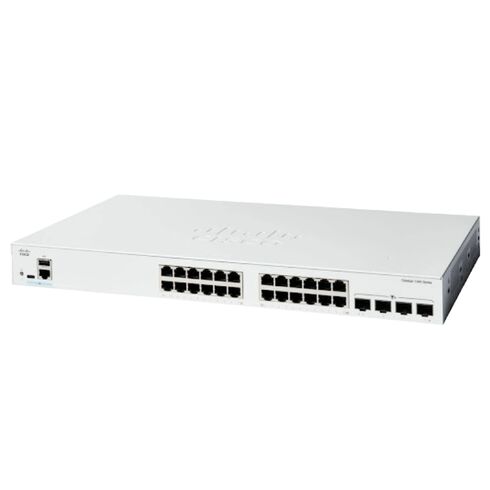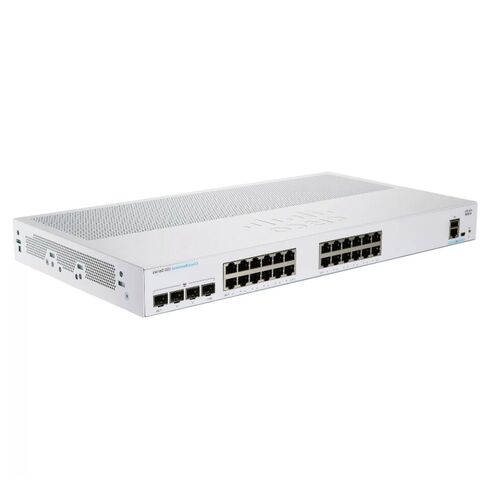C1300-24P-4G Cisco Catalyst 24-Port Managed Rack-Mountable Network Switch
- — Free Ground Shipping
- — Min. 6-month Replacement Warranty
- — Genuine/Authentic Products
- — Easy Return and Exchange
- — Different Payment Methods
- — Best Price
- — We Guarantee Price Matching
- — Tax-Exempt Facilities
- — 24/7 Live Chat, Phone Support
- — Visa, MasterCard, Discover, and Amex
- — JCB, Diners Club, UnionPay
- — PayPal, ACH/Bank Transfer (11% Off)
- — Apple Pay, Amazon Pay, Google Pay
- — Buy Now, Pay Later - Affirm, Afterpay
- — GOV/EDU/Institutions PO's Accepted
- — Invoices
- — Deliver Anywhere
- — Express Delivery in the USA and Worldwide
- — Ship to -APO -FPO
- — For USA - Free Ground Shipping
- — Worldwide - from $30
Enterprise-Grade Managed Network Switch Overview
The Cisco Catalyst C1300-24P-4G is a high-performance Layer 3 managed Ethernet switch designed for modern business networks. It delivers reliable connectivity, advanced routing capabilities, and efficient Power over Ethernet Plus (PoE+) support, making it ideal for offices, enterprises, and campus environments.
General Device Specifications
- Manufacturer: Cisco
- Model Number: C1300-24P-4G
- Network Device Type: Layer 3 Managed Switch
- Form Factor: Rack-mountable chassis
- Ethernet Technology: Gigabit Ethernet
Port Configuration and Connectivity
High-Density Ethernet Ports
- 24 x Gigabit Ethernet RJ-45 ports with PoE+
- 4 x 10 Gigabit SFP uplink interfaces
Console and Management Interfaces
- 1 x RJ-45 console port
- 1 x USB-C console interface
Power over Ethernet Capabilities
PoE+ Performance
- PoE standard: Power over Ethernet Plus (PoE+)
- Total PoE power budget: 195 watts
- Ideal for IP phones, wireless access points, and surveillance cameras
Switching Performance and Capacity
Speed and Throughput
- Forwarding rate: up to 41.66 Mpps (64-byte packets)
- Switching bandwidth: 56 Gbps
Scalability and Network Limits
- MAC address table: 16,000 entries
- VLAN support: up to 4093 VLAN IDs
- Jumbo frame size: up to 9000 bytes
Advanced Network Capacity
- IPv4 static routes: up to 990
- IPv4 interfaces: 128
- IGMP multicast groups: 2000
- Access control rules: 1024 ACLs
- Priority queues: 8
Layer 2 and Layer 3 Routing Features
Supported Routing and Switching Protocols
- Static IP routing and policy-based routing (PBR)
- RIP-2, CIDR, IPv4 and IPv6 dual stack
- STP, RSTP, MSTP, PVST+, and Rapid PVST+
- IGMPv2, IGMPv3, MLD, and multicast routing support
Security and Traffic Control Features
Advanced Network Protection
- Access Control Lists (ACL) for traffic filtering
- DoS attack prevention and storm control
- DHCP snooping, ARP inspection, and IP source guard
- Port security and MAC-based authentication
Authentication and Encryption
- Authentication methods: RADIUS and TACACS+
- Encryption algorithms: SSL and MD5
Quality of Service and Optimization
Traffic Prioritization
- Advanced QoS with DSCP-based classification
- Weighted Round Robin (WRR) scheduling
- Voice, video, and data traffic optimization
Hardware, Memory, and Reliability
Internal System Resources
- Processor: ARM-based CPU at 1.4 GHz
- System memory: 1 GB DDR4 SDRAM
- Flash storage: 512 MB
Status and Indicators
- LED indicators for system status, PoE, and link activity
Power Supply and Electrical Requirements
Internal Power Design
- Built-in internal power supply
- Input voltage: AC 100–240 V
- Frequency range: 50–60 Hz
Compliance and Industry Standards
Supported IEEE Standards
- IEEE 802.3, 802.3u, 802.3ab, and 802.3z
- IEEE 802.1Q VLAN tagging and 802.1p QoS
- IEEE 802.3af and 802.3at PoE standards
- IEEE 802.1X authentication and 802.1w/802.1s spanning tree
Ideal Use Cases
- Enterprise and SMB network infrastructure
- IP telephony and unified communications
- Wireless access point aggregation
- Video surveillance and IoT deployments
Product Category Overview
The **Catalyst C1300-24P-4G** sits in the Cisco Catalyst 1300 family, a line engineered for **branch offices and small-to-medium business networks** where cost, simplicity, and enterprise-grade features must coexist. These switches provide a balance of **performance, security, and cloud-enabled management**, making them suitable as access-layer devices in small racks or wiring closets.
Key Hardware Characteristics
Port Configuration and Uplinks
This model offers **24 Gigabit Ethernet ports with PoE+ capability** and **4 SFP Gigabit uplink ports**, enabling flexible fiber or copper uplink choices and straightforward integration into existing aggregation layers.
Power over Ethernet Budget
With a **PoE budget of approximately 195W**, the C1300-24P-4G supports powering IP phones, wireless access points, and other edge devices without separate power injectors, simplifying deployments and cabling in branch environments.
Form Factor and Deployment
Rack Mount and Physical Design
The switch is **rack-mountable** and compact, designed to fit standard 19-inch racks in branch offices. Its chassis and cooling are optimized for continuous operation in small network closets while keeping noise and power consumption reasonable for office environments.
Target Use Cases
Common deployments include **branch office access layer**, **small campus edge**, **retail and hospitality networks**, and **managed service provider edge** installations where centralized management and PoE are required for endpoint devices.
Software and Management
Management Options
The Catalyst 1300 series is manageable through **Cisco Business Dashboard** and the **Cisco Business mobile app**, offering simplified provisioning, monitoring, and firmware management for IT teams with limited on-site resources.
Layer 2 and Layer 3 Features
As a managed switch, the C1300 supports essential **Layer 2 features** such as VLANs, link aggregation, STP variants, and QoS, plus **basic Layer 3 routing** capabilities suitable for small networks that require inter-VLAN routing and static or limited dynamic routing.
Security and Access Control
Built-in security features include **802.1X authentication**, **ACLs**, and port-level controls to segment traffic and protect sensitive resources at the access layer. These features help enforce policy and reduce lateral movement risks in branch environments.
Performance and Reliability
Throughput and Switching Capacity
While optimized for branch use rather than high-density data center switching, the C1300 provides **wire-speed forwarding on all ports** for typical SMB traffic patterns, with hardware acceleration for common switching tasks and QoS handling for voice and video traffic.
Redundancy and Resilience
Resilience features include **redundant uplink options via SFP**, rapid spanning tree support, and link aggregation to maintain connectivity during single-link failures. These capabilities reduce downtime and support predictable failover behavior in small networks.
Integration and Ecosystem
Compatibility with Cisco Solutions
The C1300 integrates with Cisco’s broader portfolio, enabling **centralized visibility and policy enforcement** when used alongside Cisco access points, routers, and cloud management tools. This makes it a practical choice for organizations standardizing on Cisco technologies.
Third-Party and Migration Considerations
For organizations migrating from other vendors, the C1300’s standard protocols and SFP uplinks ease interoperability. Planning should include PoE budget calculations, VLAN and IP addressing alignment, and firmware compatibility checks to ensure a smooth transition.













